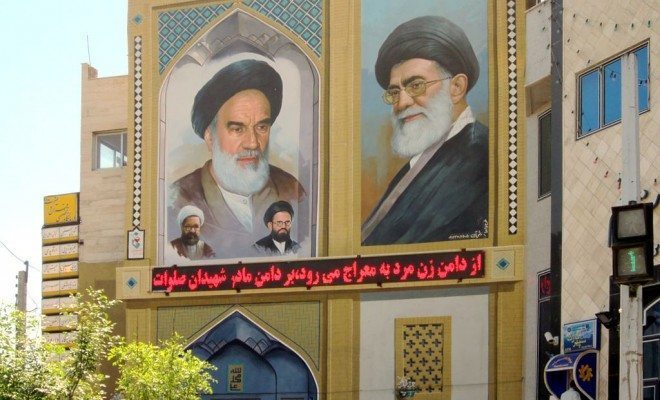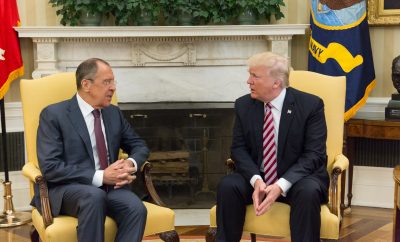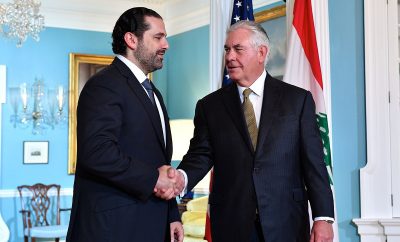 "Ayatollah Khomeini" courtesy of [David Stanley via Flickr]
"Ayatollah Khomeini" courtesy of [David Stanley via Flickr]
World
Iran’s Leadership: Inside the Complex Regime
While Iran has a parliament and president, like many western nations, its political structure is far more opaque. From the Supreme Leader to influential religious councils, understanding Iran’s leadership presents a challenge in and of itself. This challenge has been highlighted by a number of high profile events where it was unclear who had the final say in important Iranian policy decisions. Read on to learn how the Iran leadership was developed, how it is currently structured, and how that leadership defines itself both domestically and abroad.
The Revolution and Aftermath
The Iranian Revolution that occurred in 1979 was years in the making; its origins go back to at least to 1953. During that year, the CIA helped overthrow the recently elected prime minister in favor of the Shah, who had Western leanings and was an opponent of Soviet-style communism. While the Shah honored his loyalty to the United States, he was less kind to his own people, frequently imprisoning and even torturing those opposing him.
This set the stage for the revolution of 1979. This movement was led by Ayatollah Ruhollah Khomeini who returned from Paris where he had been exiled during the Shah’s rise. In place of the Shah’s one-party government, the Ayatollah installed his own based on Islamic teachings, placing himself as the country’s Supreme Leader. The new emphasis on strict adherence to Islam meant a rollback on the Shah’s few, more liberal reforms concerning the economy and women’s rights.
The following video details the specifics of the Iranian Revolution:
The Shah, who had come to power following World War II, ruled as the head of a constitutional monarchy with himself as the final arbiter. When he was deposed by Khomeini the democratic institutions that had existed were kept, however, any power they had was drained. In the new system, Khomeini ruled as the unquestioned leader of his own government which focused heavily on instilling Islamic concepts and resisting interaction with Western nations he viewed as corrupting Iran. The next sections will detail the unelected and elected elements of Khomeini’s Iran and how they are structured so that his power is virtually unchallenged.
Unelected Officials
Similar to the U.S. government, part of Iran’s government is appointed, independent of any elections. In the Iranian case, however, this aspect of the government is unquestionably the most powerful part, including many important institutions.
The Supreme Leader
As the final decision maker, the Supreme Leader has either direct or indirect control over nearly the entire government because his primary responsibility is to maintain the continued existence of the Islamic State of Iran. To ensure this, the Ayatollah has power over all three branches of government, the military, and even the state-run media. He also has power or influence on virtually every other political institution, the economy, and major policy decisions. In other words then, the Supreme Leader is the undisputed power in the Iranian regime.
The person who spearheaded the 1979 revolution and the first to hold this all important office was Ayatollah Ruhollah Khomeini. Khomeini founded the state and defined his role in it by championing four key characteristics, “justice, independence, self-sufficiency, and Islamic Piety.” Khomeini also offered a religious justification for the office, believing he held the place on earth of a 12th Imam, a descendant of the Prophet Muhammed who has since gone into hiding. Khomeini died in 1989 with no appointed successor.
The man who succeeded him and the current supreme leader of Iran is Ayatollah Ali Khamenei. Khamenei has served in this position since 1989 making him the second longest current ruler in the Middle East. Khamenei was a longtime loyalist to Khomeini and also served two terms as Iran’s president before outmaneuvering rivals for the coveted Supreme Leader position.
The Guardian Council
Next in Iran’s unelected hierarchy is the Guardian Council. The Guardian Council is arguably the most important Iranian institution aside from the Supreme Leader. The council has the final say on legislation passed by the parliament and maintains the ability to determine which candidates are eligible to run for public office in the parliament, presidency, and the Assembly of Experts. There are 12 members, six chosen by the Supreme Leader and six chosen by the judiciary and confirmed by parliament. The members of this group serve six-year terms. This group’s ability to evaluate legislation is part of its role that is similar to the U.S. Supreme Court. While the Supreme Court evaluates laws based on their adherence to the U.S. Constitution, the Guardian Council determines whether laws are compliant with both Iran’s constitution and Islamic law.
The Expediency Council
The Expediency Council serves as advisors to the Supreme Leader, much as the cabinet does to the president. This assembly is directly appointed by the Supreme Leader and consists of highly regarded political, social, and religious authorities. Aside from advising the Supreme Leader, this body’s main responsibility is to act as the final arbiter in disputes between the Parliament and Guardian Council. In 2005, it was also granted sweeping powers by the Supreme Leader over all branches of the government.
The Judiciary
Iran’s judiciary is a multi-tiered system of courts tasked with overseeing the enforcement of the law and settling grievances among Iranian citizens. The Supreme Leader has a considerable amount of control over the judiciary as he appoints its leader, who then appoints the head of the Supreme Court and the top public prosecutor. There are three main branches of the judiciary, the public courts, the revolutionary courts, and the special clerical court. While the public court deals with criminal and civil matters, the latter two courts deal with everything else.
Based the structure of the judiciary and its position beneath the Supreme Leader, many believe that it is often used as a political tool to squash dissent and maintain strict control over the people of Iran. Critics also note that the trial process in Iran is often very opaque and restrictive, allowing greater government influence.
The Revolutionary Guard
The Islamic Revolutionary Guard Corps (IRGC) is yet another body whose leadership is appointed by the Supreme Leader, along with the regular army. This group was created following the revolution to defend its key figures and fight its opponents. Unsurprisingly, this group only answers to the Supreme Leader. Aside from being in charge of militia branches in every town in Iran, the Revolutionary Guard has widespread influence throughout Iranian life.
The Revolutionary Guard’s special place both within the military and within Iran itself comes from its initial purpose of serving as an armed body loyal to the revolution as the regular army that had been loyal to the departed Shah. Since its inception, the guard has acquired billions of dollars from a variety of activities such as shipping, construction, defense contracts, and oil production. The group uses many of these assets to fund militant or extremist groups abroad such as Hezbollah. The Revolutionary Guard is so powerful, in fact, that some of the American and E.U. sanctions have targeted the IRGC specifically.
The two other major components of Iran’s defense forces are the army and the ministry of intelligence and security, which is essentially the Iranian CIA. All three of these groups are under the direction of the Supreme National Security Council. While this agency is again tentatively under the control of the president, in reality, the Supreme Leader possesses most of the control.
Elected Officials
Also similar to the United States, a portion of the Iranian government is elected by the people. Anyone over 18, including women, is eligible to vote. Also like in the American system, the different branches have some checks on one another.
The President and Cabinet
The presidency in Iran shares some of the characteristics of the same position in the United States. Namely, the presidential term is four years, and a president can only be elected for two consecutive terms. However, while the president, in theory, is the second most powerful person in Iran behind the supreme leader, reality suggests that the office’s power is drastically curtailed by unelected leaders. Not only does the president answer to the Guardian Council, which chooses who can run for the position in the first place, but the Supreme Leader retains final authority over most major political decisions. In fact, the President of Iran is the only executive in the world to not have control over the country’s military.
Parliament
Iran’s parliament has 290 members and is similar to most western legislatures. Notably, this body has its membership determined through popular elections. Once elected, members have the power to introduce and pass laws as well as summon and impeach cabinet ministers and the president. Once again, though, Parliament’s power and even who is eligible to run for office is determined by the Guardian Council. Unlike in the United States, the Iranian legislature is a unicameral body whose members serve four-year terms. The Iranian parliament’s sessions and its minutes are open to the public.
Assembly of Experts
The final part of Iran’s leadership that is directly elected is the Assembly of Experts. There are 86 members of this body and each one is elected to an eight-year term. To be considered, each member must be a cleric or religious leader. This group has the critical responsibility of appointing and subsequently monitoring the Supreme Leader. Members of this group are vetted first by the Guardian Council, the primary check on its influence. This group meets for only one week each year and although it has the power to depose the Supreme Leader it has never challenged any of his decisions since the Islamic Republic of Iran formed. The accompanying video gives a concise explanation of how the Iranian government is organized:
Major Challenges Facing Iran’s Leadership
Domestic Dissent
Protests in Iran became particularly significant in the 20th century, as Iranian citizens frequently spoke out against the government. For the first half of the century, this was aimed at the decadent dynastic government and later colonial masters. The resistance then focused on the Shah, which eventually led to the Iranian Revolution. Following the revolution, discontent emerged in 2009 when people took to the streets to dispute then President Ahmadinejad’s reelection. In 2011, another flare-up of protests occurred concurrently with the Arab Spring revolts in nearby countries. Much of the protest again focused on the contentious 2009 elections and were led by the Green Movement.
International Relations
Political decisions in Iran are often the result of a complex process that is typically driven by the Supreme Leader. Given the nature of the Iranian government, several international concerns have significant implications for the country and how its government responds.
Possibly the most pressing concern facing Iran is its proxy war with Saudi Arabia. The two countries have effectively positioned themselves as the defenders and standard bearers of Islam, but champion different denominations. This is especially true of the Supreme Leader who feels it is his mission to lead Islam and who also views Saudi Arabia as an obstacle in the way of that. This proxy conflict threatens to turn into more direct action if Iran reneges on its nuclear deal. The video below details the proxy war between Iran and Saudi Arabia:
The recent nuclear deal between Iran and the United States brings up another important challenge for the country. While the two groups have worked together to finalize the deal, a conflict remains. Aside from the history of distrust between both countries, Iran’s support for a number of groups such as Hezbollah and Hamas–which are considered terrorist organizations by the U.S. State Department–and its anti-Israel policy remain hurdles.
Conclusion
Iran has a large and complex leadership structure, which originated in the aftermath of the revolution in 1979. On one hand are democratic institutions such as the president and parliament, which are similar to American and Western models. On the other are a series of appointed offices that wield a significant portion of political power in the country. At the heart of this system lies the Supreme Leader who has control over many of the appointments and final say over virtually all of the country’s affairs. This system itself is a reaction to the previous secular regime of the Shah, which was founded upon a greater emphasis on Islamic law as well as inherent animosity toward the United States.
Iran is a mixture of theocracy and democracy, and understanding how Iran is governed and run is critical to understanding how to effectively deal with it. As history has shown, many countries, particularly the United States, have misinterpreted or misjudged the nation’s leadership.
Resources
The New York Times: 1979: Iran’s Islamic Revolution
United States Institute of Peace: The Supreme Leader
BBC News: Guide: How Iran is Ruled
Your Middle East: Iran’s Century of Protest
Global Security.org: Pasdaran: Iran Revolutionary Guard Corps (IRGC)
The Guardian: Iran Protests See Reinvigorated Activists Take to the Streets in Thousands
Politico: The Hidden Consequences of the Oil Crash
The New York Times: U.S. and Iran Both Conflict and Converge
Encyclopedia Britannica: Mohammed Reza Shah Pahlavi
United States Institute of Peace: The Oil and Gas Industry
PBS: The Structure of Power in Iran








Comments